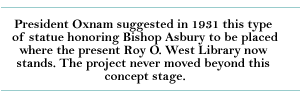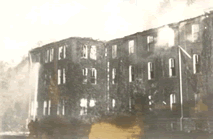
Pages:
<< Back 1
2 3 4
5 6 7
8 9 10
Next >>
In
the meantime West College, the oldest building on campus, had
been condemned as unsuitable for classroom use. Many alumni hoped
that "Old Asbury," as the former Edifice was sometimes
known, might be restored. But the trustees decided to replace the
once-rebuilt structure with a new classroom facility perpetuating
the memory of the pioneer Methodist bishop after whom the university
had originally been named.


In
1930 Asbury Hall was erected on West Campus, across from Middle
College. Its construction was made possible in a time of economic
depression by borrowing from the university's endowment fund as
well as by special gifts. Housing the social science and humanities
departments, Asbury soon became one of the most frequented places
on campus. A few years later West College was razed, but President
Oxnam's plan for an equestrian statue of Francis Asbury on its site
was never realized.
 ______________________________________________ ______________________________________________
Asbury
Hall was dedicated in 1930. Largely housing
classrooms and
offices for the humanities and social
science departments it has
probably been the busiest
building in the second half of the 20th
century on the
DePauw Campus.
______________________________________________
Asbury Hall also represented a new type of architecture on campus.
It was designed by the indifatigable Robert F. Daggett in the Georgian
or Colonial Revival mode which the board of trustees had adopted
in 1929 as the official architectural style for future DePauw buildings.
Its wide chimneys at either end of the central section, dormer windows
and reverse-gable roof on the outer sections, and red-brick walls
were typical features of the Colonial Williamsburg style that was
becoming popular on many university campuses at the time and was
to dominate DePauw architecture over the next few decades. In 1935
the Publications Building, financed largely by means of revenues
from the student newspaper and yearbook, was constructed next to
Asbury Hall in the same style. Some living units built in this period
were also designed in Colonial Revival style, such as the Sigma Nu house on the corner of Seminary Street and College Avenue. Other
additions to the campus in the Oxnam administration were a new maintenance
building erected behind Middle College in 1930 and a small fieldhouse
at Blackstock Field, paid for from student athletic fees, in 1933.
In the summer of 1931 four concrete tennis courts were built behind
Bowman Gymnasium.

In the early morning hours of Sunday, October 12, 1933, fire broke
out in Mansfield Hall, causing damage estimated at $100,000 to the
oldest women's dormitory on campus. An intrepid coed carried Mildred
Dimmick, the housemother, who had sprained her ankle, out of the
burning building, but the only casualty was the president's son,
Robert Oxnam, who was struck but not seriously injured by a piece
of plaster while taking part in the rescue of residents' belongings.
Most of the displaced women were assigned to Johnson House, a frame
building on Walnut Street donated to the university some years before
by Greencastle resident D. B. Johnson and used up to this time for
housing male students. A few freshman sorority pledges were allowed
to take up residence in their chapter houses.
After an appraisal of the partly-destroyed building that indicated
the unfeasibility of restoring it, Mansfield Hall was razed and
the site landscaped. The threat of fire to another building of the
same vintage and type of construction brought about the evacuation
of Middle College not long afterwards. The botanical and zoological
laboratories were moved from the building's upper stories to a frame
structure first erected as an annex to Florence Hall. Other departments
were relocated in Asbury Hall, and in 1934 the old college building
that had been originally designed as a men's residence hall was
finally demolished, the third such campus landmark to disappear
in this period. Financial constraints postponed the planned construction
of a new women's dormitory, a science classroom building, and more
capacious facilities to replace the outdated Carnegie Library.
 
President Oxnam, concerned about reports of falling church attendance,
inaugurated a special interdenominational vespers service on Sunday
evenings that proved popular with students. Daily morning chapel
was continued on a voluntary basis, but with religious services
only on Wednesday. By 1933 this worship chapel and the Sunday evening
vespers were conducted in the sanctuary of Gobin Memorial Church,
its ecclesiastical setting and the robed university choir adding
much to the dignity and solemnity of the occasion. On other weekdays
chapel was held in Meharry Hall, featuring talks by the president,
professors, or visiting speakers, with usually a musical program
on Friday. President Oxnam himself was a frequent chapel speaker,
sometimes choosing controversial topics dealing with contemporary
social issues or discussing his summer travels in Europe or the
Orient. Through his wide contacts with pacifist and social reform
circles he was able to bring to campus leading figures in those
movements, including Norman Thomas, Kirby Page, and Sherwood Eddy.
One program in 1935 was devoted to a student demonstration for world
peace.
Shortly after his arrival on campus President Oxnam gave evidence
of his own antimilitarist views by issuing an administrative order
making participation in R.O.T.C. voluntary rather than compulsory.
Both the faculty and the student body had discussed this idea before
but without any decision being made. Despite outcries from the American
Legion and similar organizations, Oxnam went even farther in 1934,
calling upon the trustees to abolish the entire R.O.T.C. program
at DePauw. The board quickly complied with his wishes, ending the
university's second experience with student military training in
peace time. On the whole, both the university and church constituency
came to the support of the president in this matter against his
many detractors in other quarters.
Oxnam was also eager to continue the work of his predecessor, President
Murlin, in reorganizing and strengthening the university's administration.
When Post retired from the deanship in 1930, Murlin elevated William
M. Blanchard to dean of the university. Blanchard had been assisting
Dean Post since 1927. Blanchard also acted as director of admissions,
though much of the work of reviewing transcripts and the like fell
to an enlarged registrar's office, headed first by Vera Worth and,
after her marriage to the widowed dean in 1933, by her assistant,
Veneta J. Kunter. Also active in admissions decisions was the secretary
of the Rector Scholarship Foundation, Henry
B. Longden.
Back
to Top
Pages:
<< Back 1
2 3 4
5 6 7
8 9 10
Next >>
|




 ______________________________________________
______________________________________________


